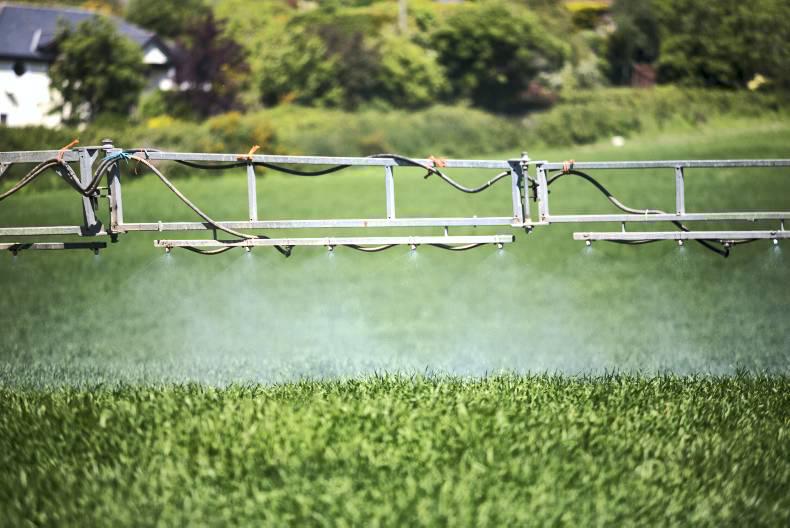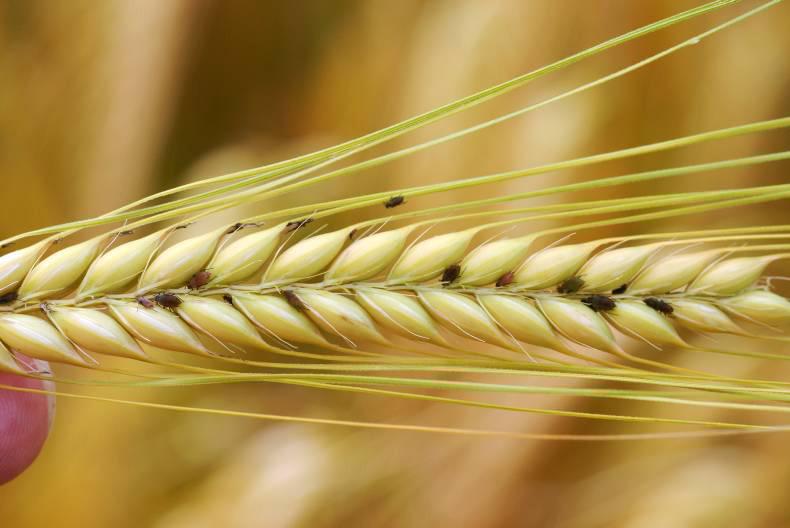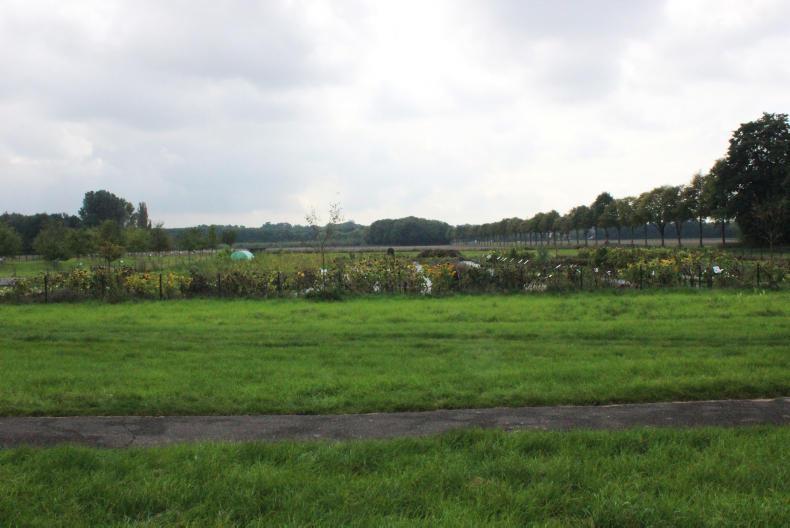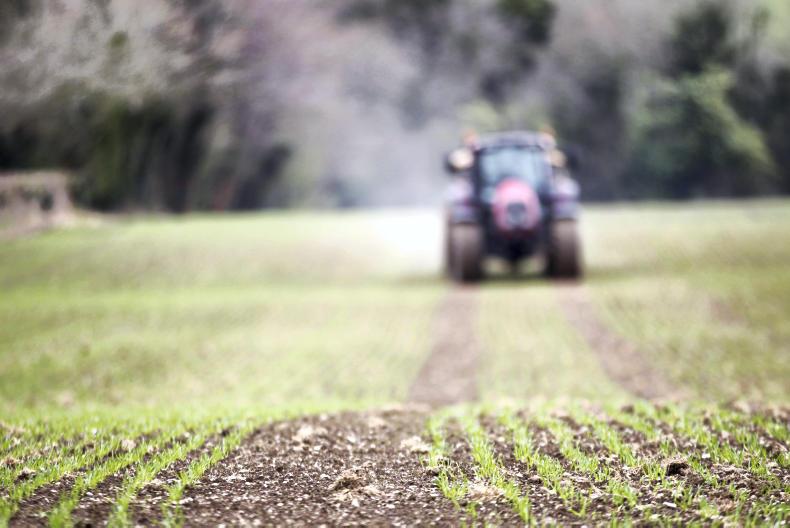As in recent years, 2016 has brought many changes for the chemical store. It is important to be aware of these changes in case you get caught out by having a product in store that is no longer cleared for use. You must always remember that it is your responsibility to keep your spray store in order and this is one good reason to have a written list of all the products in your store.
The number of active substances available to you as a farmer has decreased significantly over the past two decades. At EU level we had around 1,000 actives in the market in 1990 and only about 230 of these remained in 2015. A number of new actives (approximately 180) were added in this intervening period, leaving us with around 400-450 actives today. But nearly a quarter of this number are of no consequence to us in Ireland, so the net shrinkage in the number of actives has been very severe.
The appearance rate of new actives entering the market is down to a mere trickle relative to the rate of market introduction in the 1990s and early 2000s. The net effect is that farmers have fewer tools with which to protect their crops and they also have fewer tools with which to protect the products that protect their crops.
One of the main concerns regarding the reducing number of actives available is that there is a reducing number of families of chemical actives remaining to protect our primary actives from resistance build-up. Every time we lose an existing family, we are left with one less option to protect other families of actives.
We still have a threat of the loss of most, if not all, of the triazoles pending the long-awaited definition of an endocrine disruptor. If triazoles are lost before the appearance of new and active fungicide families, cereal production in this country will be very vulnerable.
While there may be an increasing awareness of the importance of having a number of families of actives in the market at EU level, the groups with responsibility for these decisions care little about where the EU gets its food or the continued lack of competitiveness being imposed on EU farmers.
While no one, including farmers, wants to have products in the market that are unsafe, the degree of hazard or risk imposed by any product needs to be weighed up against the essential nature of the foods being produced. Less-safe products should be removed when they can be replaced by ones that are accepted as being safer for man and environment. But that’s a different thing to removing actives and leaving the incomes of farmers completely exposed as a consequence.
Product loss
In 2015 and 2016, quite a number of plant protection products have had their registrations revoked. Most of these will have been products that have come up for reregistration. As I write this article there is a significant cloud being cast over the reregistration of glyphosate (Roundup). This begs the question as to the reasoning or justification for these recent decisions.
Some of the actives that have come up for reregistration over the past year include chlorpyrifos (Dursban), pirimicarb (Aphox), MCPA and chlormequat (CCC). Some have been reregistered, others remain on hold, while some have not been reregistered.
There are many possible reasons as to why important actives (for Ireland) might not be reregistered. These include:
Lack of appropriate data to support reregistration.Potential income in the market is not justified relative to registration cost.Market size too small. Data reveals unacceptable risk to man or the environment.The increasing number of actives brought to the market as parallel imports or generic equivalents has helped to reduce their cost to the farmer but the lower-priced market now challenges the cost/benefit ratio for the manufacturer. Where this is not deemed to be satisfactory, the registration holder can decide that a continuation of registration is not worthwhile.
Political influence
Politics has become an increasing issue also in recent years. In the past, any product that was registered for use generally went on to act out its registration period in the market to help recoup its investment cost. Nowadays, more and more products are being challenged midstream and withdrawn. An example of this was the neonicotinoid insecticides which were withdrawn from use post-registration.
One can never quibble when good science identifies a genuine problem associated with a product in the market. However, it would seem that a level of poor science is being allowed to affect decisions via the political route. This is a dangerous game. But perhaps science itself, or scientists to be more precise, have let down the profession by producing two different conclusions with regard to the cancer risks posed by the same active through a review of the same literature.
I refer to the difference of opinion expressed by the EFSA and WHO scientists with regard to the cancer risks associated with the use of glyphosate. When science differs like this, then consumers have a reason to be worried. This difference of opinion was at least a contributory factor in the recent decision to postpone a vote on the reregistration of glyphosate, a postponement that could well be bad news for this important global active in the EU.
There is now fear that the decision could move entirely into the political rather than the scientific arena and that glyphosate could well be lost to the EU market. This would be an enormous loss to both commercial farming and consumers and could well be a decision that could awaken societies to the folly of what is happening in this arena.
Insecticides
Another big decision which has been made recently relates to the revoking of chlorpyrifos. This was removed from sale on 1 March last with a use-up period set for 31 March. Normally when products are removed from the market there is an 18-month period allowed for the residual product in the market to be used up.
This normally allows for six months to sell out existing stock plus 12 months to use it up at farm level. But in the case of chlorpyrifos products (Dursban, Clinch, Sipyrfos and Trigger), there was only one month between the ending of sale and the final use-up. Indeed, it was not so much a use-up period but rather a return of unused product to distributor level.
This very sudden departure of chlorpyrifos from the market leaves a big gap in our ability to control specific pests such as leatherjackets and carrot root fly in many crops. It was also used as an aphicide in many crops and in places where growers were afraid of resistance to pyrethroid insecticides in pests such as aphids and flea beetle.
It seems that the major issue with regard to chlorpyrifos was with regard to the risk of operator exposure. This is a serious issue so it is hardly surprising that withdrawal was virtually instant. One product containing chlorpyrifos remains in the market but this is a methyl formulation and its use in grain stores and foggers does not involve direct user exposure. The product is Reldan 22 (PCS 03623) and it has only recently been reregistered but not for use through a standard sprayer.
Chlorpyrifos is an important insecticide, especially for leather-jacket control in cereals and other pests in vegetable crops. There is now no straightforward alternative left for leatherjacket control in cereals. Draza filled that role for many years but it too was taken from the market, with its last use on 19 September 2015. This now leaves crop producers with virtually nothing in the way of a product to control these soil pest problems when they occur.
Another aphicide – Aphox – is due to be reregistered and it is expected that it will lose many of its existing crop uses due to environmental issues. This was one of the few options for aphid control in spring barley and this use may be lost. We must hope that some new actives can make their way to the market to replace it.
Herbicide changes
Straight MCPA has been another permanent casualty for cereal producers. All straight formulations had their registration revoked at the end of December last and all product in stock or on farm has to be used up by the end of June 2017. While there has not been much MCPA used on cereal crops in recent years, it was one of the tools that might be added where weeds had developed resistance to some of the sulfonylurea herbicides. However, products that contain MCPA in a co-formulation with another active can still be used on cereals.
One potential benefit from this move is to isolate the use of MCPA and its worrying presence in water samples to its use on grassland by grass farmers only. The frequent discovery of MCPA in surface water had potentially serious consequences for grain farmers also and this may help isolate crop producers from suspicion for this specific problem.
Basta is another product that has been removed from the market with a use-by date set at 30 September 2017. The graminicide Aramo must also be used up later this year, before 16 November 2016.
The grassland herbicide Genoxone ZX has been given a use-by date of 30 September 2017 but it has been replaced by a new version but with a much lower maximum application rate and a new PCS number.
Fungicide changes
A number of cereal fungicides containing fenpropidin, such as Tern (PCS 00598)/Patrol (02502) and Winger, have been revoked with use-by dates of 1 October 2016 and 31 July 2017 respectively. Tern has been re-registered, as has Patrol, and both have been given a 15m watercourse buffer. It is also worth noting that the maximum application rate for both of these has been reduced to 0.5 l/ha from 1.0 l/ha. Frelizon (04913) and Furlong (03183) fungicides have also been revoked, with use-by dates set at 30 June 2017 and 30 September 2017 respectively. Both products have been reregistered with new PCS numbers.
Score (00329) has a use-by date of 30 September 2017, but it too has been reregistered with a different PCS number. It remains very important to check the label of any product with an altered PCS number as specific use details could have been changed in the reregistration.
In some instances products have been withdrawn from the market even though their registration remains intact and stocks can be used. These include products like Cherokee, Elumis, Foundation, Menara and Stereo. Ranman Twinpack is also to be removed from the potato market with last use by 30 June 2017. Four products containing cymoxanil – Cymbal, Globe, Option PM and Proxanil – have also been revoked, but Cymbal, Option and Proxanil have been reregistered.
Growth regulators
Many products containing cycocel also had their registration revoked but the active has been re-registered and most products are back on the market but with different PCS numbers. The same is true for Ceraide but it too has been reregistered and stocks with the 90390 PCS number must be used up by 30 June 2017.
Take care with labels
As indicated in this article, many products have been given new PCS numbers in recent times. It is essential to remember that this could well signify a relevant alteration to label rates or timings. An example of this is the reduction in the maximum dose rate for Tern and Patrol to 0.5 l/ha and the reduction in the maximum total dose to 1.0 l/ha. So, as always, growers would be well advised to cross check simple basic details when using a known brand with a different PCS number.
To read the full Crop Protection Focus Supplement, click here.
As in recent years, 2016 has brought many changes for the chemical store. It is important to be aware of these changes in case you get caught out by having a product in store that is no longer cleared for use. You must always remember that it is your responsibility to keep your spray store in order and this is one good reason to have a written list of all the products in your store.
The number of active substances available to you as a farmer has decreased significantly over the past two decades. At EU level we had around 1,000 actives in the market in 1990 and only about 230 of these remained in 2015. A number of new actives (approximately 180) were added in this intervening period, leaving us with around 400-450 actives today. But nearly a quarter of this number are of no consequence to us in Ireland, so the net shrinkage in the number of actives has been very severe.
The appearance rate of new actives entering the market is down to a mere trickle relative to the rate of market introduction in the 1990s and early 2000s. The net effect is that farmers have fewer tools with which to protect their crops and they also have fewer tools with which to protect the products that protect their crops.
One of the main concerns regarding the reducing number of actives available is that there is a reducing number of families of chemical actives remaining to protect our primary actives from resistance build-up. Every time we lose an existing family, we are left with one less option to protect other families of actives.
We still have a threat of the loss of most, if not all, of the triazoles pending the long-awaited definition of an endocrine disruptor. If triazoles are lost before the appearance of new and active fungicide families, cereal production in this country will be very vulnerable.
While there may be an increasing awareness of the importance of having a number of families of actives in the market at EU level, the groups with responsibility for these decisions care little about where the EU gets its food or the continued lack of competitiveness being imposed on EU farmers.
While no one, including farmers, wants to have products in the market that are unsafe, the degree of hazard or risk imposed by any product needs to be weighed up against the essential nature of the foods being produced. Less-safe products should be removed when they can be replaced by ones that are accepted as being safer for man and environment. But that’s a different thing to removing actives and leaving the incomes of farmers completely exposed as a consequence.
Product loss
In 2015 and 2016, quite a number of plant protection products have had their registrations revoked. Most of these will have been products that have come up for reregistration. As I write this article there is a significant cloud being cast over the reregistration of glyphosate (Roundup). This begs the question as to the reasoning or justification for these recent decisions.
Some of the actives that have come up for reregistration over the past year include chlorpyrifos (Dursban), pirimicarb (Aphox), MCPA and chlormequat (CCC). Some have been reregistered, others remain on hold, while some have not been reregistered.
There are many possible reasons as to why important actives (for Ireland) might not be reregistered. These include:
Lack of appropriate data to support reregistration.Potential income in the market is not justified relative to registration cost.Market size too small. Data reveals unacceptable risk to man or the environment.The increasing number of actives brought to the market as parallel imports or generic equivalents has helped to reduce their cost to the farmer but the lower-priced market now challenges the cost/benefit ratio for the manufacturer. Where this is not deemed to be satisfactory, the registration holder can decide that a continuation of registration is not worthwhile.
Political influence
Politics has become an increasing issue also in recent years. In the past, any product that was registered for use generally went on to act out its registration period in the market to help recoup its investment cost. Nowadays, more and more products are being challenged midstream and withdrawn. An example of this was the neonicotinoid insecticides which were withdrawn from use post-registration.
One can never quibble when good science identifies a genuine problem associated with a product in the market. However, it would seem that a level of poor science is being allowed to affect decisions via the political route. This is a dangerous game. But perhaps science itself, or scientists to be more precise, have let down the profession by producing two different conclusions with regard to the cancer risks posed by the same active through a review of the same literature.
I refer to the difference of opinion expressed by the EFSA and WHO scientists with regard to the cancer risks associated with the use of glyphosate. When science differs like this, then consumers have a reason to be worried. This difference of opinion was at least a contributory factor in the recent decision to postpone a vote on the reregistration of glyphosate, a postponement that could well be bad news for this important global active in the EU.
There is now fear that the decision could move entirely into the political rather than the scientific arena and that glyphosate could well be lost to the EU market. This would be an enormous loss to both commercial farming and consumers and could well be a decision that could awaken societies to the folly of what is happening in this arena.
Insecticides
Another big decision which has been made recently relates to the revoking of chlorpyrifos. This was removed from sale on 1 March last with a use-up period set for 31 March. Normally when products are removed from the market there is an 18-month period allowed for the residual product in the market to be used up.
This normally allows for six months to sell out existing stock plus 12 months to use it up at farm level. But in the case of chlorpyrifos products (Dursban, Clinch, Sipyrfos and Trigger), there was only one month between the ending of sale and the final use-up. Indeed, it was not so much a use-up period but rather a return of unused product to distributor level.
This very sudden departure of chlorpyrifos from the market leaves a big gap in our ability to control specific pests such as leatherjackets and carrot root fly in many crops. It was also used as an aphicide in many crops and in places where growers were afraid of resistance to pyrethroid insecticides in pests such as aphids and flea beetle.
It seems that the major issue with regard to chlorpyrifos was with regard to the risk of operator exposure. This is a serious issue so it is hardly surprising that withdrawal was virtually instant. One product containing chlorpyrifos remains in the market but this is a methyl formulation and its use in grain stores and foggers does not involve direct user exposure. The product is Reldan 22 (PCS 03623) and it has only recently been reregistered but not for use through a standard sprayer.
Chlorpyrifos is an important insecticide, especially for leather-jacket control in cereals and other pests in vegetable crops. There is now no straightforward alternative left for leatherjacket control in cereals. Draza filled that role for many years but it too was taken from the market, with its last use on 19 September 2015. This now leaves crop producers with virtually nothing in the way of a product to control these soil pest problems when they occur.
Another aphicide – Aphox – is due to be reregistered and it is expected that it will lose many of its existing crop uses due to environmental issues. This was one of the few options for aphid control in spring barley and this use may be lost. We must hope that some new actives can make their way to the market to replace it.
Herbicide changes
Straight MCPA has been another permanent casualty for cereal producers. All straight formulations had their registration revoked at the end of December last and all product in stock or on farm has to be used up by the end of June 2017. While there has not been much MCPA used on cereal crops in recent years, it was one of the tools that might be added where weeds had developed resistance to some of the sulfonylurea herbicides. However, products that contain MCPA in a co-formulation with another active can still be used on cereals.
One potential benefit from this move is to isolate the use of MCPA and its worrying presence in water samples to its use on grassland by grass farmers only. The frequent discovery of MCPA in surface water had potentially serious consequences for grain farmers also and this may help isolate crop producers from suspicion for this specific problem.
Basta is another product that has been removed from the market with a use-by date set at 30 September 2017. The graminicide Aramo must also be used up later this year, before 16 November 2016.
The grassland herbicide Genoxone ZX has been given a use-by date of 30 September 2017 but it has been replaced by a new version but with a much lower maximum application rate and a new PCS number.
Fungicide changes
A number of cereal fungicides containing fenpropidin, such as Tern (PCS 00598)/Patrol (02502) and Winger, have been revoked with use-by dates of 1 October 2016 and 31 July 2017 respectively. Tern has been re-registered, as has Patrol, and both have been given a 15m watercourse buffer. It is also worth noting that the maximum application rate for both of these has been reduced to 0.5 l/ha from 1.0 l/ha. Frelizon (04913) and Furlong (03183) fungicides have also been revoked, with use-by dates set at 30 June 2017 and 30 September 2017 respectively. Both products have been reregistered with new PCS numbers.
Score (00329) has a use-by date of 30 September 2017, but it too has been reregistered with a different PCS number. It remains very important to check the label of any product with an altered PCS number as specific use details could have been changed in the reregistration.
In some instances products have been withdrawn from the market even though their registration remains intact and stocks can be used. These include products like Cherokee, Elumis, Foundation, Menara and Stereo. Ranman Twinpack is also to be removed from the potato market with last use by 30 June 2017. Four products containing cymoxanil – Cymbal, Globe, Option PM and Proxanil – have also been revoked, but Cymbal, Option and Proxanil have been reregistered.
Growth regulators
Many products containing cycocel also had their registration revoked but the active has been re-registered and most products are back on the market but with different PCS numbers. The same is true for Ceraide but it too has been reregistered and stocks with the 90390 PCS number must be used up by 30 June 2017.
Take care with labels
As indicated in this article, many products have been given new PCS numbers in recent times. It is essential to remember that this could well signify a relevant alteration to label rates or timings. An example of this is the reduction in the maximum dose rate for Tern and Patrol to 0.5 l/ha and the reduction in the maximum total dose to 1.0 l/ha. So, as always, growers would be well advised to cross check simple basic details when using a known brand with a different PCS number.
To read the full Crop Protection Focus Supplement, click here.











SHARING OPTIONS